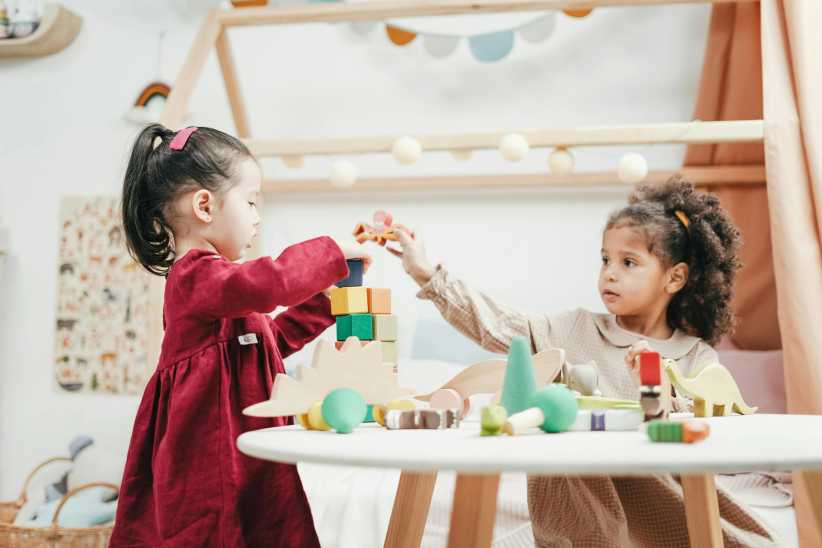Youth apparel is a billion-dollar industry that peaks each fall with back-to-school clothes shopping. To get the biggest bang for your buck, begin with planning.
“The most common mistake shoppers make is buying too much on impulse when faced with a large selection, or buying too much of the wrong thing,” says family budgeting expert and consumer economist Dr. Pam Norum. “Although the plan-and-budget mantra may have an ominous ring, it’s really as simple as taking an inventory of what your child has and deciding what he or she needs.”
Scott Krugman, spokesman for the National Retail Federation, agrees.
“Before leaving home, have a game plan. Know what your child needs and what you want to purchase. Otherwise, you’ll be overwhelmed when you get to the stores.”
To do this, take inventory of your child’s closet with him. Determine what still fits, what needs to be replaced, and what items will be willingly worn again. This, says Norum, is critical for building on an existing wardrobe when you have a limited budget.
“Take special note of workable basic pieces — jeans, skirts, tops, other pants — and major color influences,” she says.
Next, make a shopping list of the basic items needed, based on the closet inventory. Although this list should be your guide, leave some room for flexibility. Your child may see an extra-special sweater that matches two or more basics in her wardrobe.
After taking inventory, establish a clothing budget for each child. While not every family can spend the estimated $220 per child, it is important that you decide — before you go shopping — what you can afford to spend.
“Equally important is to know your price point,” says Krugman. “Are you going to spend $15 for that pair of jeans, or $50?”
When budgeting, keep in mind that as a child’s age increases, so does the price. As children move into adolescence, parents can expect a gradual 25 percent hike in clothing prices, Norum warns.
“The combination of increased peer awareness and pure size — more fabric, construction, and fashion features — adds to the bottom line,” she says.
Older children also tend to have a wider variety of social activities that require a more diverse wardrobe. Since adolescents are in the throes of growth spurts, it is best to spread purchases over a longer period of time. And don’t forget about alterations. Those too-little pants or jeans can be easily made into shorts or capris.
While a budget is partly about establishing spending limits, it is also about getting the most value for your money.
“Since elementary-age kids, 6 to 11, tend to be more rough and tumble, value often comes from buying quality, durable clothing with easy-to-care-for features,” says Norman, who believes wearability is value. When assessing additions to your child’s wardrobe, consider these points.
• Durability. Look for good enough quality to withstand repeated washings while remaining colorfast and not shrinking. Check for reinforced stitching and well-sewn buttons and buttonholes. When purchasing knits, go with fabric that is more dense than loose, with limited stretching. Keep in mind growth features such as elastic waistbands, adjustable straps, and longer shirt tails.
• Versatility. Staples, such as jumpers for girls and khakis for boys, are great dress-it-up or dress-it down pieces, as are various colored T-shirts. Mixing and matching with the basics — jeans, tops, and other pants or skirts — make a wardrobe work harder.
• Quality. Getting the most value for your money means budgeting for quality. Backpacks and jackets, for example, are likely candidates for heavy wear and tear. “For items like these, it’s a good idea to buy brands you trust,” says Krugman. “Some items, such as backpacks, even come with warranties.”
• Comfort. Children need to be comfortable when they are in a learning environment. When trying clothes on in the dressing room, have your child sit, kneel, twirl around and bend over. Are the clothes tight anywhere? Do they ride up or fall down? Are they itchy? If so, it may distract your child while he or she is trying to learn.
For most children, today’s clothing makes a lifestyle statement — one that can stoke an emotional standoff when needs versus wants enter the financial equation. There may be times when your child wants something more than your budget allows, or an item you simply find inappropriate.
“Conflicts are inevitable with children who don’t understand that clothes are subject to spending caps,” Norum says.
Krugman agrees.
“This is another reason why you should have a game plan before leaving home. You and your child will know what the expectations are, and you may be able to avoid conflicts altogether.”
When conflicts over clothing do occur, seize the opportunity to discuss the reason for spending limits with your child. This is usually tied to parents’ personal convictions about what is and isn’t extravagant.
“This is an important way to impart values and introduce ideas that will make the child a competent money manager as he or she grows up,” says Norum.
If the situation warrants, consider a compromise.
“This keeps fun and camaraderie in the picture as parents and kids plan for back-to-school,” she says. Norum recommends setting aside at least 10 percent of the overall budget. “That way, when you encounter an item that isn’t essential, but extra special, your child has some freedom of choice.”
“This is a good way to approach it,” says Krugman, who offers yet another option: let children use their own money to buy that “must-have item,” he says. “Kids these days are spending more and more of their own money on back-to-school clothes. If they find something they want, and it isn’t in your budget, let them purchase it themselves.”
Overall, preparing a back-to-school wardrobe can be a fun and rewarding experience. The key is to plan ahead, establish a budget, and keep an open line of communication with your child. Then, you can shop for style with savings in mind.
Yearian is the former editor of two parenting magazines and the mother of three children.
Did you know?
Statistics show that parents tend to spend more on girls’ clothing than on boys. This is due, in part, to girls’ higher interest in apparel. Girls’ clothing also tends to be slightly higher-priced than boys’ because of special details, such as lace, buttons, and fancy collars.





















